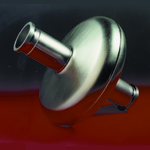For more than 20 years, solid niobium has had the monopoly on high-gradient applications of superconducting radio frequency (SRF) cavities for particle accelerators. But it will soon have reached its limits. It was only recently that A. Gurevich, a theoretician from Florida State University, put forward a theory explaining the reasons behind niobium's success and a way of breaking its monopoly. Until now, this theoretical model had never been experimentally demonstrated. This has now changed for a collaborative project between IRFU (Saclay) and INAC (Grenoble) has just made this vital step towards new acceleration technology.


